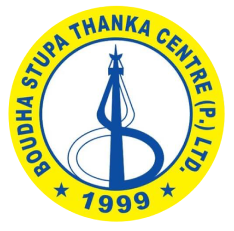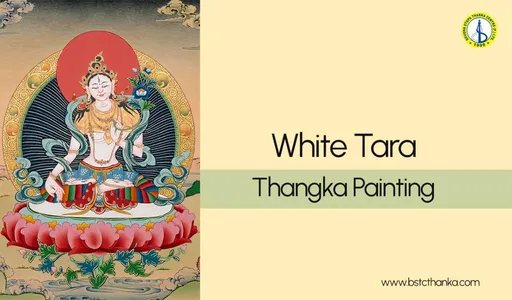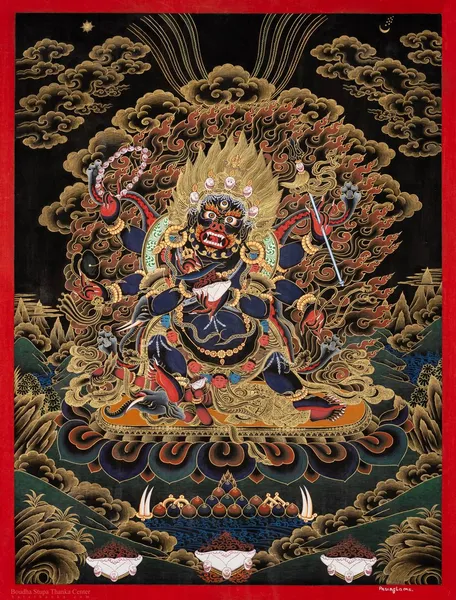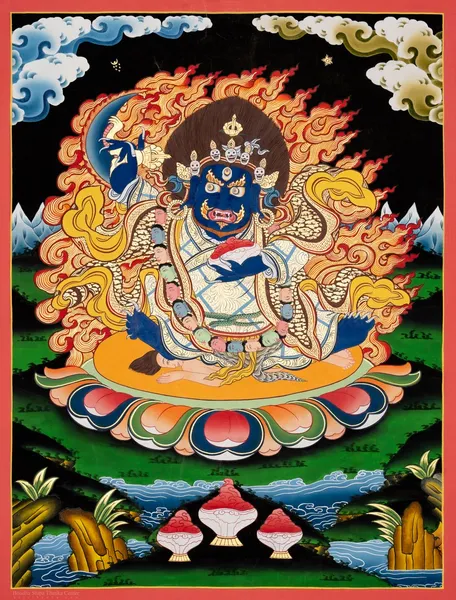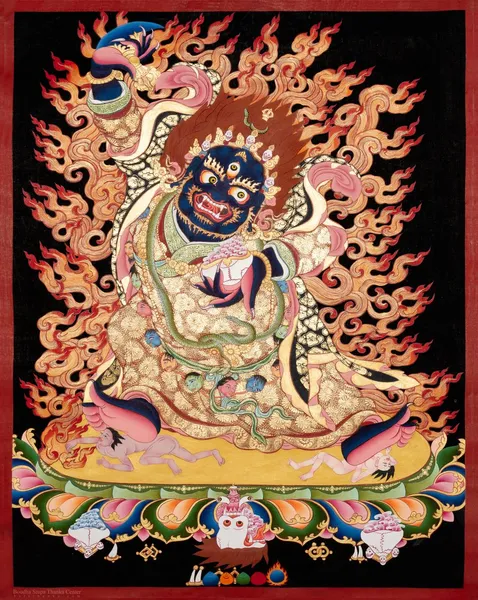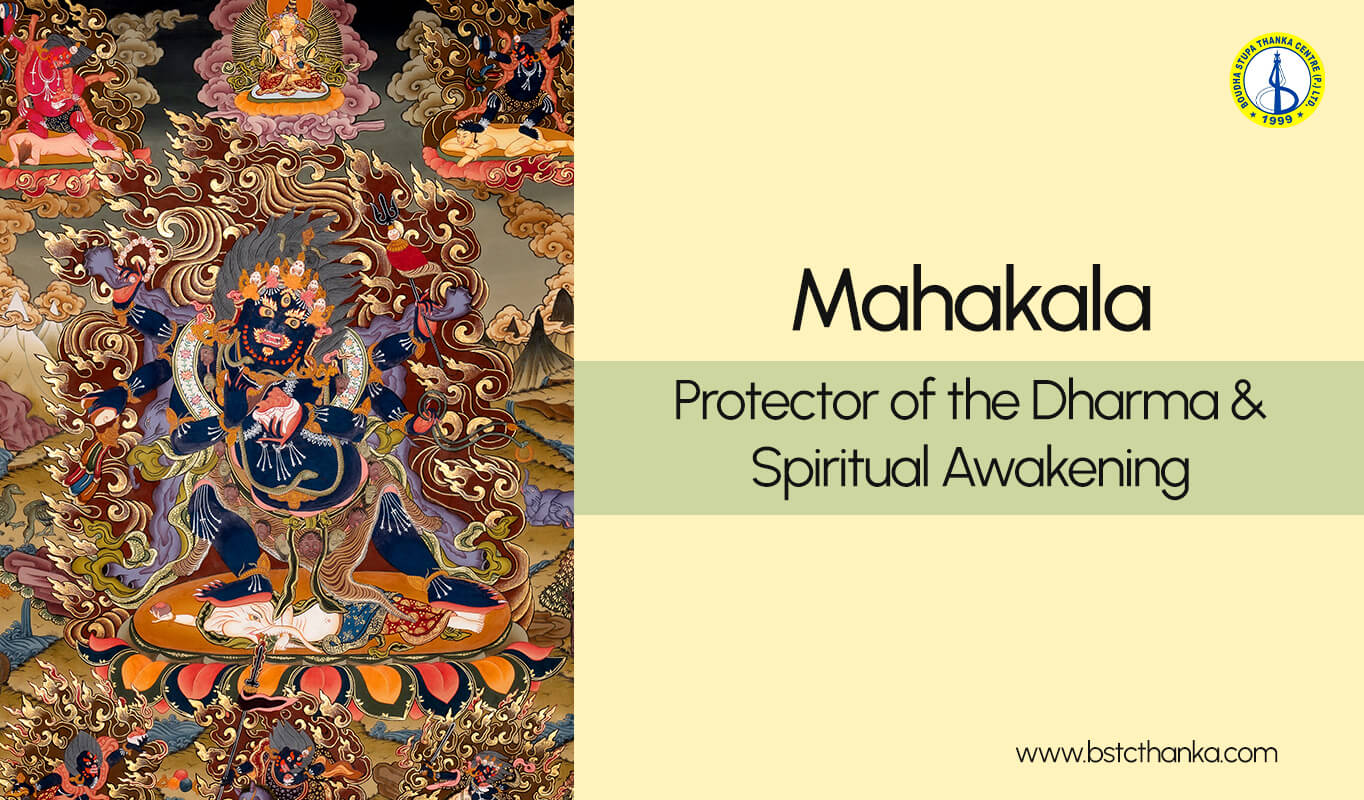
Mahakala Deity
Mahakala Deity
Mahakala is a significant deity in Eastern religions, including Hinduism and Tibetan Buddhism. The name "Mahakala" is derived from two Sanskrit words "Maha" means "Great," and "Kala" means "Time or Death." Thus, Mahakala translates to "Great Death" or "Great Time," signifying ultimate power over time and death. The name Mahakala translates from Sanskrit to "Great Black One," and Mahakala deity lives up to its name in both Hinduism and Buddhism. However, his appearances and roles can differ quite a bit between these two traditions.
In Buddhism Mahakala is highly revered as a protector deity and is often depicted in a fierce and wrathful form, symbolizing the destruction of obstacles and other evil forces.
Mahakala belongs to one of the various classes of powerful beings in the universe. The Mahakala deities are known to create many problems for sentient beings. So, to control them, Avlokiteshvara took the form of Mahakala and integrated himself into the class. Mahakala is not a worldly guardian but a manifestation of Sambhogakaya, which is why he is sometimes used as Yidam, a meditation deity.
Mahakala is often depicted with dark skin, a fierce expression, and multiple arms holding weapons. He is surrounded by primordial fire, symbolizing blazing wisdom, and wears a crown of skulls to show his powerful presence. The five skulls on the crown symbolize the transformation of the five poisons -- anger, desire, ignorance, jealousy, and pride -- into wisdom. Mahakala is respected as a guardian in all major schools of Tibetan Buddhism.
Mahakala Mantra
The below are the different versions of Mahakala Matra in Buddhism:
- Om Shri Mahakala Hum Hum Phat
- Om Mahakalaya Soha
- Om Benza Nara Trim Trim Hung Hung Phet Phet Soha
Chanting the Mahakala mantra as part of Tantra practices can help remove negative energy and clear obstacles that block prosperity, wealth, and good luck. It's also used to remove confusion, doubt, and ignorance. This practice is believed to dispel charms, counteract black magic, repel evil spirits, and prevent enemy harassment.
The mantra can be easily used by the general people as a means of garnering concentration during meditation.
Mahakala in Different Religions
The Hindu Mahakala Deity
In Hinduism, Mahakala is a fierce aspect of the god Shiva. Often depicted with four arms and three eyes, he is associated with time, creation, destruction, and power. He resides in cremation grounds, symbolizing his dominion over the cycle of death and rebirth. His consort is the goddess Mahakali Deity, and together they represent time's destructive power. Mahakal is often associated with the ultimate power of destruction and regeneration in Hinduism. The Mahakaleshwar Jyotirlinga, one of the twelve sacred shrines dedicated to Shiva, is located in Mahakala Temple at Ujjain, India, where Mahakala is worshiped as Mahakaleshwar.
In Tibetan Buddhism
In Tibetan Buddhism, Mahakala deities are worshiped as a Dharma protector, safeguarding the teachings and practitioners of Buddhism. He takes on various forms, with the most popular ones being the six-armed, four-armed, and two-armed avatars. Each form serves a unique purpose, from offering protection to removing obstacles. Within Buddhism, Mahakala takes on the role of a Dharmapala, Dharmapala is a protector of the Dharma, Dharma is known for the teachings of the Buddha. He is a wrathful manifestation of a Buddha, representing the fierce power of compassion that cuts through negativity and ego attachments. Mahakala is a particularly prominent figure in Vajrayana Buddhism, especially Tibetan Buddhism, where he appears in various forms.
In General Buddhism
In general Buddhist traditions, Mahakala is seen as a wrathful manifestation of Avalokiteshvara, the Bodhisattva of Compassion. Despite his fearsome appearance, he embodies the compassionate act of eliminating obstacles to enlightenment.
Different Forms of Mahakala
Mahakala exists in several forms, each with unique characteristics and wrathful appearance. Despite his fearsome appearance, Mahakala is not a deity to be feared. His wrath is a tool for positive transformation, aiding practitioners on their path to enlightenment by destroying obstacles and negativity. Mahakala is devoted as a guardian who ensures that only those who are sincere can progress on the spiritual path. The number of arms is the most obvious variation, but there are other differences as well. These are some of the most popular forms of Mahakala that can be seen in traditional tibetan thangka paintings:
1. Mahakala Bernagchen
The Mahakala Bernagchen is typically depicted with 2 arms and is also known as the Great Black One. Mahakala Bernagchen is highly revered in Karma Kagyu and other Tibetan Buddhist traditions.
Mahakala Berangchen is depicted in tibetan traditional thangka art with the following features:
- Dark black or blue color that represents the void of ultimate reality.
- In his right hand, he holds a curved knife or chopper to symbolize cutting through delusions and obstacles.
- In his left hand, he holds a heart, representing compassion and removal of suffering.
- He wears a crown of 5 skulls and is adorned with snake and bone ornaments, representing power over death and impermanence.
2. Mahakala Gimpo Gur
Mahakala Gompo Gur is another manifestation of the Mahakala in Tibetan Buddhism. "Gompo" means "protector," and this form of Mahakala is particularly associated with the Nyingma and Kagyu traditions.
In traditional tibetan thangka art Mahakala Gimpo Gur is depicted with the following features:
- He is often portrayed in a dark color which represents the emptiness of reality
- He can have multiple arms ranging from two to six.
- In his right hand, Mahakala often holds a curved knife or a kartika, and in his left hand, he holds a skull cup (kapala) filled with blood. These symbolize the subjugation of evil forces and the transformation of negative energies
Mahakala Gimpo Gur is further adorned with a crown of skulls and typically has three eyes symbolizing his all-seeing nature. He is often seen wearing a garland of severed heads with snake and bone ornaments.
Iconography of Mahakala Deity
Mahakala, the "Great Black One," is a powerful deity with a rich visual language across Hinduism and Buddhism. His iconography, often angry and symbolic, reflects his multifaceted role as a destroyer of negativity and a protector of the Dharma. Let's delve into the key features that define Mahakala's visual representation:
Appearance
Color:
- Black / Dark Blue: The dominant color representing Mahakala's wrathful nature and his association with dissolution.
Number of Arms:
- Four or Six: The most common depictions. Four arms symbolize his power and ability to act in the four cardinal directions. Six arms represent his connection to the six realms of existence in Buddhism.
Heads and Hair:
- Three Faces: Representing the past, present, and future, or the seeing of all realities.
- Flaming Hair: Symbolizes his burning wisdom that destroys negativity.
Asana (Posture):
- Standing or Seated: Standing postures depict his active power, while seated postures suggest his contemplative wisdom.
- Seated on Corpses: Symbolizes his mastery over death and ego.
Crown:
- Five Skulls: Representing the transmutation of the five negative emotions (anger, greed, ignorance, envy, and pride) into the five wisdoms of the Buddha.
Ornaments of Mahakala Deity
Mahakala deity’s ornaments symbolize his protective and fierce nature, each holding deep symbolic meaning, often depicted in thangka art:
- Necklace: Made of skulls, symbolizing the cycle of life and death and the power to conquer death.
- Crown: Adorned with five skulls, representing the transmutation of the five negative afflictions into wisdom.
- Leg: Often depicted in a dancing posture, crushing demons underfoot, signifying the subjugation of evil forces.
- Arms: Multiple arms holding various weapons (Trident, Sword, Kartika, Kapala etc) and ritual objects, each symbolizing different aspects of protection, power, and the removal of obstacles.
Weapons of Mahakala Deity
Mahakala uses different weapons that represent the power to remove obstacles and protect the Dharma. These weapons are the significance of his strong nature and ability to eliminate negative forces, ensuring the spiritual growth and protection of practitioners. The weapons used by the Mahakala deity include:
- Trishula (Trident): Represents the destruction of ignorance, desire, distractions, and ability to pierce through illusion and negativity.
- Sword: Symbolizes the cutting through of delusion and the attainment of wisdom.
- Kartika(Ritual Knife): A Kartika is an axe-like curved weapon that signifies the harvesting of karmic results and the removal of obstacles.
- Skull Cup (Kapala): Holds the blood of enemies, symbolising the transformation of negative energies.
- Drum (Damaru): Represents the sound of Dharma and the cosmic rhythm of creation and destruction signifing the primal sound of creation and destruction.
Mahakala in Different Countries
Mahakala is a Dharma protector deity with a rich history and symbolism. Whether encountered in his wrathful Hindu form or his caring Japanese appearence, Mahakala offers a unique perspective on the forces that shape our world. The worship (reverence) for Mahakala extends beyond India and Nepal. In Japan, he is known as Daikokuten, a much more caring, kind (benevolent) figure. He is a popular household deity, bringing wealth and fortune, and is counted among the Seven Lucky Gods according to Japanese tradition.
In Nepal
In Nepal, Mahakala deity is highly respected, especially in the Newar Buddhist community. Referred to as "Bhairab" in certain contexts, Mahakala is seen as a strong defender of the Dharma. Temples and shrines dedicated to Mahakala can be found throughout the Kathmandu Valley, where rituals and ceremonies are carried out to seek his protection and blessings. His presence is often depicted in thangka paintings and sculptures, highlighting his role as a guardian deity.
In China
In China, Mahakala is primarily recognized within the Tibetan Buddhist tradition, which has a significant following in regions such as Tibet and Inner Mongolia. He is known as "Daheitian" (大黑天) and is worshiped as a powerful guardian of the Buddhist teachings. Chinese representations of Mahakala often include intricate mandalas and statues, highlighting his fearsome and protective nature. Monasteries perform regular rituals to honor Mahakala, seeking his aid in overcoming obstacles and ensuring the prosperity of the monastic community.
In Japan
In Japan, Mahakala, known as "Daikokuten" (大黒天), has been connected with Shinto deities and is often associated with wealth and prosperity rather than his more wrathful aspects. Mahakala deity is considered one of the Seven Lucky Gods (Shichifukujin) and is depicted holding a mallet and standing on bales of rice, symbolizing abundance and good fortune. While his protective qualities are still acknowledged, the focus in Japanese culture tends to be more on his benevolent attributes, bringing blessings and success to his devotees.
Representation of Mahakala Thangka
The Mahakala thangka is usually represented as black or dark blue deity in traditional art and sculptures. This represents Mahakala's ability to take in all names and forms and change them into his own, showing his all-encompassing and complete nature. Just as all colors are taken in and disappear into the darkness, the black color shows Mahakala's status as the ultimate reality. It can also show the complete absence of color.
In thangka paintings, Mahakala is typically depicted wearing a crown adorned with five skulls, representing the conversion of the five negative aspects into the five wisdoms.
Mahakala's depictions can vary in the number of arms and other details. For example, Mahakala can be depicted in white, with multiple heads, without genitals, standing on different numbers of various objects, holding various weapons, and with different ornaments.
Mahakala Deity: Frequently Asked Questions (FAQ)
Who is Mahakala?
Mahakala, meaning "Great Black One" in Sanskrit, is a complex deity appearing in both Hinduism and Buddhism. He is depicted as a powerful and often wrathful figure.
What are Mahakala's different forms?
- Hindu Mahakala: A fierce aspect of Shiva, associated with time, creation, destruction, and residing in cremation grounds.
- Buddhist Mahakala: A Dharmapala, protector of the Buddha's teachings. He embodies the fierce compassion that cuts through negativity.
Is Mahakala scary?
Despite his wrathful appearance, Mahakala is a protector, not a figure to be feared. His wrath destroys negativity and obstacles on the spiritual path.
What is Mahakala's role in Buddhism?
Mahakala is a prominent figure in Vajrayana Buddhism, especially Tibetan Buddhism. He appears in various forms, guarding the Dharma and ensuring only sincere practitioners progress.
Is Mahakala worshipped anywhere else?
Yes! In Japan, Mahakala is known as Daikokuten, a benevolent god of wealth and fortune.



